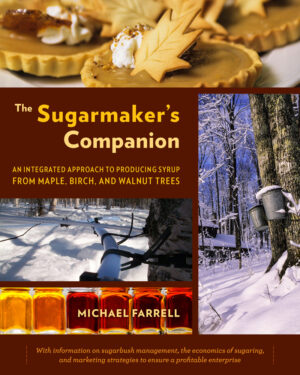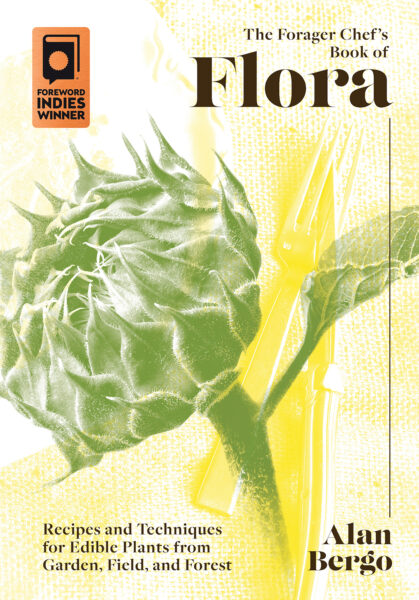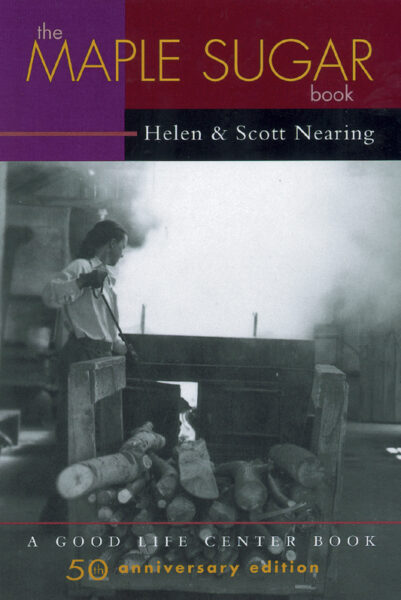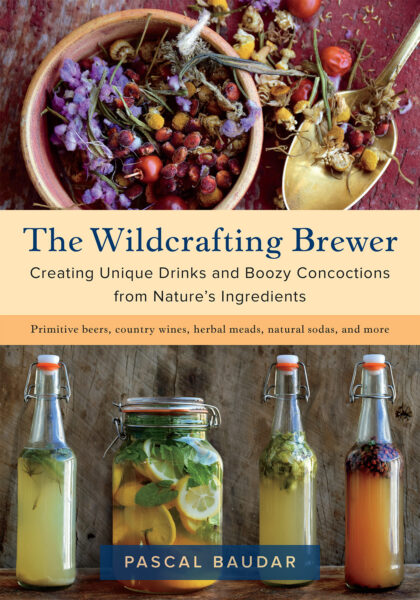Tree Sap: Nature’s Energy Drink
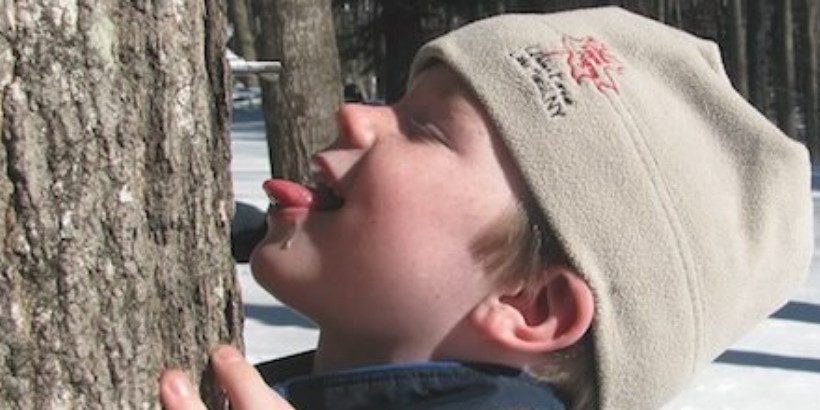
There’s nothing better than kicking back after a long day with a nice cool glass of tree sap. Sounds sticky, but you might be surprised to hear that sap from maple, birch, or walnut trees is comprised mostly of water with 2 percent or less sugar and loaded with minerals, nutrients, enzymes, antioxidants, and more—an incredible, all-natural beverage.
The following is an excerpt from The Sugarmaker’s Companion by Michael Farrell. It has been adapted for the web.
The first year I tried making maple syrup was pretty much a disaster. My father, brother Jeremy, and I tapped several trees on our property in Lake George in an attempt to produce maple syrup. We didn’t do nearly enough research beforehand and consequently burned many of my mother’s favorite pots.
To say that our syrup took on a smoky flavor would certainly be an understatement! The lone bright spot in our adventure was discovering how delicious the sap was—fresh from the tree or partially boiled down into an even sweeter, golden liquid. After several failed attempts at making syrup, we gave up on that aspect altogether and just drank the sap. Whatever sap we didn’t drink fresh got boiled down for 20 to 30 minutes on the stove until we had created “Adirondack Sweetwater.” While I certainly love pure maple syrup, drinking the sap is what really got me hooked on sugaring.
Drinking Sap: Fresh or Pasteurized
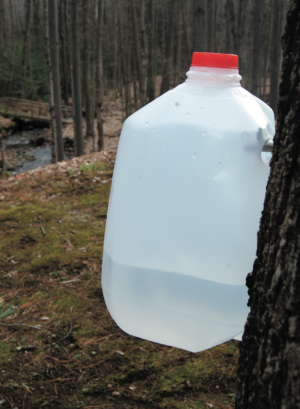
If you are planning on drinking sap without first pasteurizing it, a clean 1-gallon jug with a small hole cut out to let it hang on the spout works great. Simply take it off the spout, stick it in the fridge, and replace it with a new jug. The best jugs to use for this purpose are ones that previously contained water, although other food-grade containers can be used after cleaning and rinsing. Photo courtesy of Jeremy Farrell.
Some people enjoy drinking sap fresh from the tree, while others prefer to boil it for a brief period to kill any bacteria or yeast. Since it is certainly possible for harmful bacteria to be found in sap, the cautious solution is to pasteurize it before drinking. However, this will kill all the bacteria, both good and bad, thereby precluding possible consumption of probiotics that are important for human health.
It is worth noting that maple sap is basically sterile inside the tree; it is not until it is exposed to the atmosphere or comes in contact with collection equipment that it picks up various strains of bacteria. Luc Lagace, a maple researcher with Centre ACER in Quebec, has spent considerable time and resources along with his colleagues identifying the bacterial communities commonly found in maple sap. They recently used advanced technology to identify a wide array of bacterial communities found at the taphole, with Pseudomonas and Rahnella the most commonly occurring genera. Although it is possible that probiotics could become introduced into the sap, it is also possible that harmful bacteria could make their way in.
For this reason, I always recommend filtering and pasteurizing the sap before drinking—just to be safe. In the same way that municipalities implement a “boil water” policy whenever there is a water main break, I also always recommend sterilizing the sap before drinking. I would feel terrible if someone wound up with contaminated sap (based solely on their collection practices) and then became ill themselves or made other people sick by serving contaminated sap to them. While there is a good chance you could drink raw sap your entire life and never get sick from it, when you are serving sap to other people (or recommending them to try it), it is always best to err on the side of caution.
Carbonated Sap
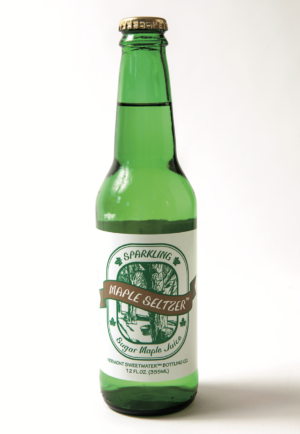
FIGURE 12.8. The maple seltzer currently being produced by the Vermont Maple Sweetwater Bottling Company. Photo by Nancie Battaglia.
If you are a fan of carbonated beverages, you can make a fresh maple seltzer simply by using maple sap instead of water in a home carbonation machine. There are plenty of different models on the market that are relatively inexpensive and easy to use. Simply substitute maple sap (or birch or walnut sap) for water and use the carbonation machine as directed. With your own carbonator, you can control the level of fizziness in your seltzer and make it fresh whenever you want. I highly recommend this to anyone who likes carbonated beverages. As an added bonus, you’ll also be able to make your own maple soda (as described in detail in chapter 11).
There is a company in Vermont that has been instrumental in commercializing the concepts discussed above. Brothers Bob and Rich Munch applied for and received a patent in 1995 to create the products that they market through Vermont Sweetwater Bottling Company. Their patent covers the methods of pasteurization, filtration, concentration, and bottling of carbonated maple sap. A 2009 article in The Atlantic featured their successful business, which now sells roughly 10,000 cases each year.11 In addition to carbonated maple sap, they also make a pure maple soda and several other flavored soft drinks. Although not all of their beverages utilize maple sap and syrup, these two products provided the impetus to develop their thriving company.
Commercializing Tree Sap
To date there has been much more commercial activity with bottling and selling birch sap than there has been with maple sap. A quick Internet search for “birch sap” reveals a wide variety of purveyors throughout Europe, Russia, and Asia. There are many websites where you can buy pure birch sap or other beverages that utilize birch sap as the main ingredient. Most of the products use citric acid to preserve the sap, and many come with added sugars. The main obstacle that most companies encounter is preserving tree sap for year-round consumption while still maintaining the flavor and health benefits of fresh sap. The other challenge is trying to supply a market for 52 weeks when the sap is only running for less than a month.
This requires a lot of warehousing and strategic planning to ensure a steady supply at an affordable price. It also requires a great deal of marketing and outreach to teach the public about maple and/or birch sap. Most people are originally skeptical of drinking tree sap, so you need to offer samples and do whatever outreach is needed to get people to understand why maple and birch sap are incredible, all-natural beverages. Once people taste the sap and discover that it is just like pure water with a hint of natural sweetness, they will gladly buy it. However, if you just put it on a shelf somewhere and hope somebody will try it, chances are you won’t sell much.
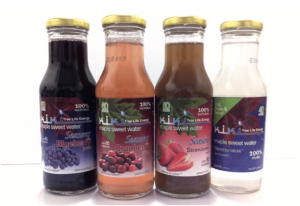
Pure maple sap and three fruit-flavored varieties offered by Troll Bridge Creek Inc. in Ontario. Photo courtesy of Keith Harris.
Maple Sap
They have since greatly expanded production and branched out to include blueberry-, strawberry-, and cranberry-flavored versions that have pure fruit juice added to the maple sap. For a couple of years they also had lemon-ginger and lemon-mint flavors, but these were not as popular so are no longer offered. The response from health food stores has been remarkable; over 150 outlets across Canada now carry their products. Keith is also in conversations with a number of Asian businesses to export their maple sap to Korea, China, and Japan. The last few years have seen a surge in activity with bottling maple sap. In 2009 Keith Harris retired from his corporate job and started Troll Bridge Creek Inc. with his wife, Lorraine, in Ontario, Canada. Keith decided to use his science and business background to start an entirely new venture in bringing maple sap to the marketplace as an all-natural, healthy beverage. Within a year Troll Bridge Creek Inc. developed the KiKi Maple Sweet Water brand and bottled thousands of gallons of maple sap in 12-ounce glass bottles.
Over the past year he has been working with researchers at Conestoga College in Ontario to develop additional processing techniques to preserve maple sap for year-round consumption. The idea is to then license this technology to others so that sugar makers throughout the United States and Canada could also bottle and sell pure maple sap as a healthy beverage. Stay tuned for further developments in coming years.
Not all of the maple sap commercialization is happening in Canada. Here in the United States, I have come across several restaurants and health food stores selling maple sap in various forms over the past several years. Most notably, in 2012, Feronia Forests, LLC, a sustainable forestry company and certified B-corporation with timberland holdings in Massachusetts and New York State, started researching various processes to extend the shelf life of maple sap. After positive developments in their first year, Feronia bottled enough maple water in a shelf-stable manner to run a regional test market in the summer of 2013. They are planning a commercial launch of maple water in the spring of 2014 under the label Vertical Water. Feronia’s Vertical Water will soon provide added growth to the subsegment of all-natural functional waters category, much in the way coconut waters have done over the past few years.
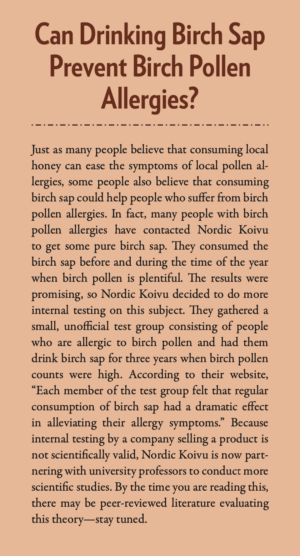 Birch Sap
Birch Sap
Rather than being processed into syrup, the majority of birch sap collected in the world is used as a beverage. Most of it is converted into what’s known as a “Forest Drink” (or a similar translation) that involves adding sugar to the sap and preserving with citric acid and/or heat treatment for year-round consumption. Although there is a good market for this type of beverage, a company in Finland is taking a different approach. Susanna and Arto Maaranen have developed a unique method of preserving birch sap without having to heat, freeze, or refrigerate the sap.
Their company, Nordic Koivu, is able to keep the birch sap in a natural state and therefore maintain all the health benefits of fresh birch sap for everyday use throughout the year. They have not yet patented their technology, because doing so would reveal the trade secrets that they have spent years of research and development to discover.
The temperatures are usually much warmer when birch sap is flowing as compared with maple. Therefore the sap is more likely to spoil and needs to be collected and processed carefully and quickly. Nordic Koivu has developed a custom-made sap collection system, utilizing stainless steel and a special type of plastic that allows the company to maintain the highest-quality sap for as long as possible.
They are also working on a project to have subcontractors collect birch sap, which they would then deliver to the plant for processing and bottling. They originally experimented with having another company collect sap for them; once that proved successful, they have expanded to include another four or five sap collectors. This allows them to focus on processing, bottling, and marketing the sap without having to worry about gathering it. By having trained people gather the sap with customized and specific materials, they can also ensure a high-quality product.
Recommended Reads
Recent Articles
Everyone loves a refreshing, fermented, nutritious drink…even your garden! Take your fermentation skills out of the kitchen and into the garden by brewing fermented plant juice. The following is an excerpt from The Regenerative Grower’s Guide to Garden Amendments by Nigel Palmer. It has been adapted for the web. How to Make Fermented Plant Juice Fermented…
Read MoreOh, honeysuckle…how we love thee. If only there was a way to capture the sweet essence of this plant so we could enjoy it more than just in passing. Luckily, foraging and some preparation can help make that happen! Here’s a springtime recipe that tastes exactly like honeysuckle smells. The following excerpt is from Forage,…
Read MoreWant to see your crops thrive this upcoming growing season? The key is in soil fertility and health. Spend time maintaining your soil’s health to guarantee bigger and better crops come harvest time! The following is an excerpt from No-Till Intensive Vegetable Culture by Bryan O’Hara. It has been adapted for the web. What Is Soil Fertility?…
Read MoreIntroducing…your new favorite brunch dish! This whole broccoli frittata is packed with fresh, wildcrafted flavors that are bound to help you start your day off on the right foot. The following is an excerpt from The Forager Chef’s Book of Flora by Alan Bergo. It has been adapted for the web. RECIPE: Whole Broccoli Frittata…
Read MoreMany know the effects of catnip on our feline friends, but few realize that catnip has medicinal effects for humans. From stomach aches to reducing fevers, catnip is a versatile herb with many benefits. The next time you grow this plant for your cat you may end up taking a few cuttings for yourself! The…
Read More

